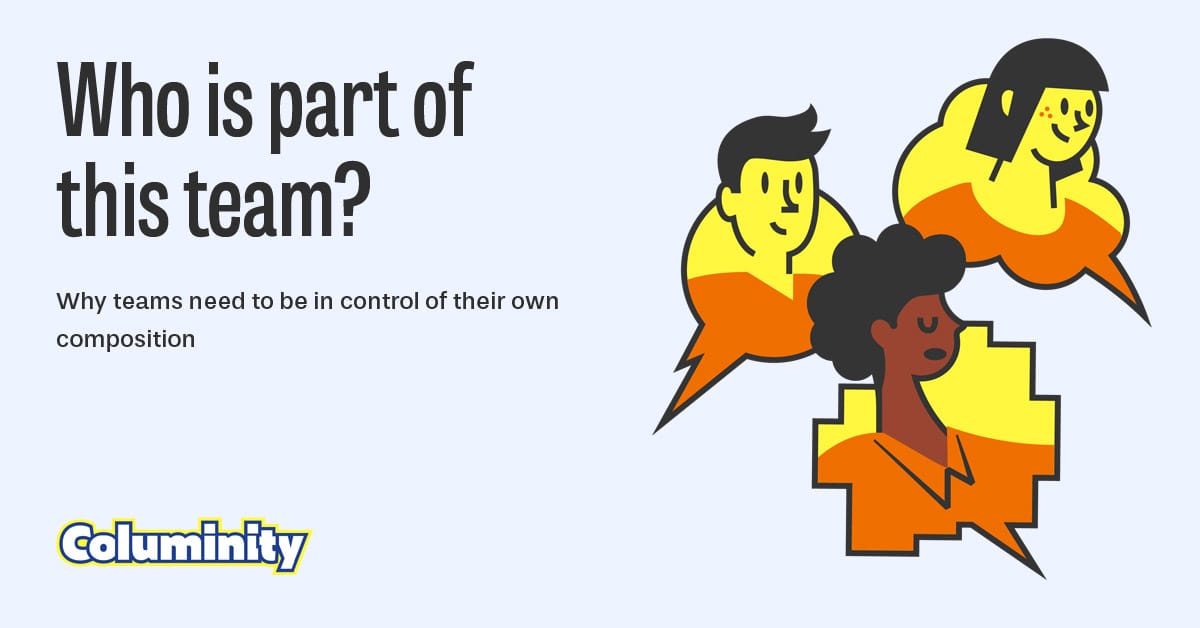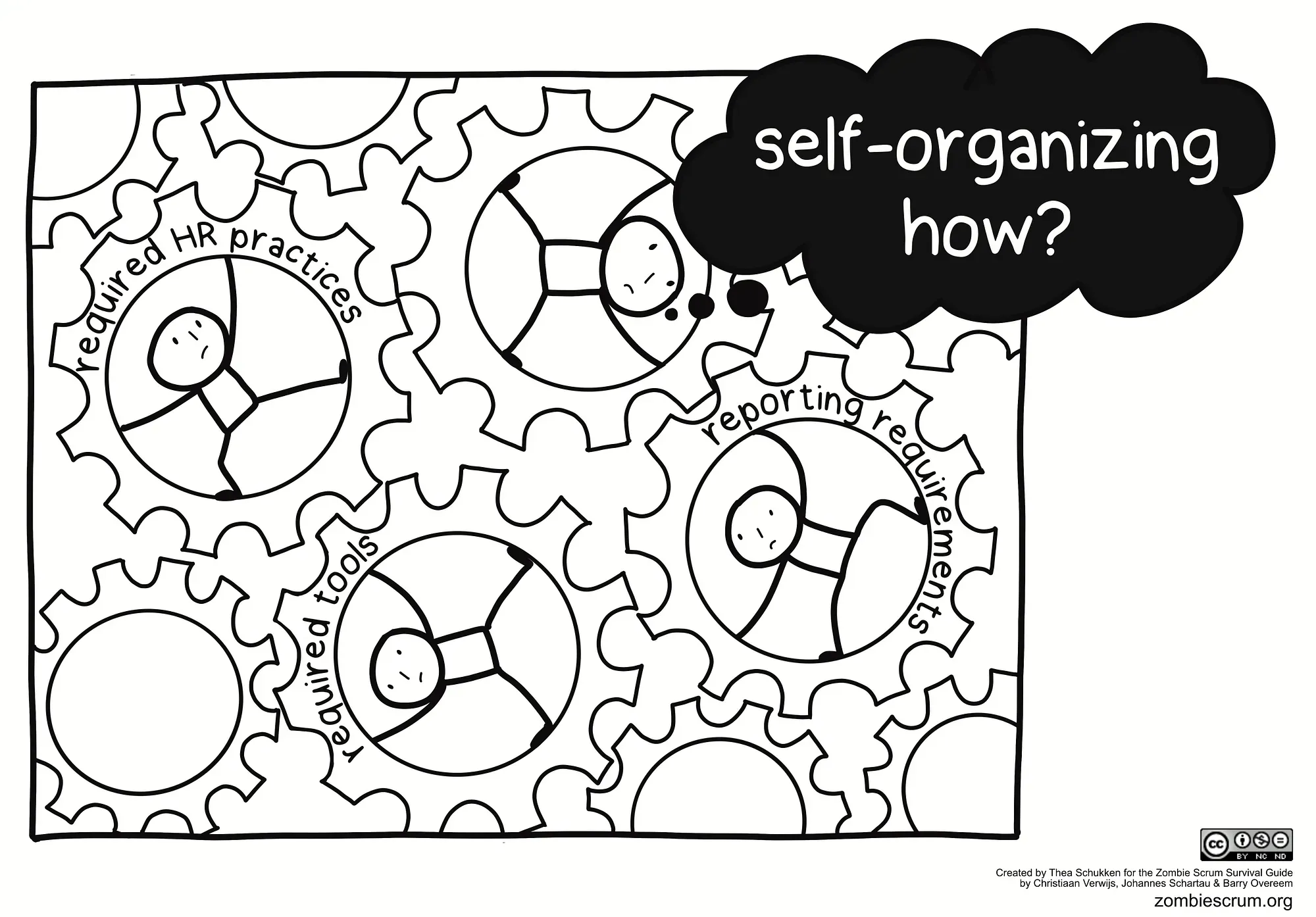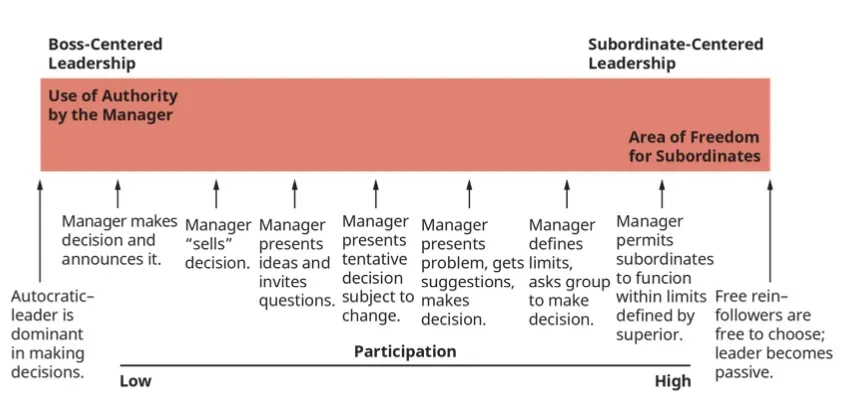"Who is part of this team?", and why teams need to be in control

Who decides who is part of a team? Is this decision primarily up to the members themselves? Or does management decide everything? Or is it somewhere in between?
This type of autonomy is called team composition autonomy. Many organizations are still figuring out how to provide it, given the increasing emphasis on autonomous teams for non-routine work. Our preliminary data from teams participating in Columinity suggest that such autonomy is still modest. About 45% of teams say they have no autonomy in this area, 25% say they have little autonomy, and only 10% report high autonomy.
In this post, we dive deeper into team composition autonomy. The basis for this post is we are on a mission to unleash teams through an evidence-based approach. We begin with a brief overview of the scientific consensus on team autonomy. Then, we will explore practical interventions. We hope this post will give you pause to think about many valuable points, whether you’re a team member, a coach, or a manager.
You can measure the level of team composition autonomy for your team(s) with Columinity. Go to teamworkquality.columinity.com to try now. Our free plan is great for individual teams, but with a paid plan you can track this factor - and many others - across many teams in the same or different organizations.
Scientific research on team composition autonomy
The notion of teams and teamwork as a managerial concept emerged during the 1950s and 60s (Thamhain & Willemon, 1987). Until then, most of the work was industrial and relied mostly on skills and repetitive tasks. Thus, work design ignores human factors like motivation, job satisfaction, and leadership. A landmark paper by Trist & Bamforth (1951) reported how coal miners relied on responsible autonomy to deal with the dangerous nature of their work without a managerial class that didn’t travel down into the darkness of the mines with them. Mining teams picked their workmen, provided training, and often took care of the families of workmen who died in the mines. The need for high autonomy was further developed in the socio-technical systems approach (Hackman & Oldham, 1980). It coincided with an emerging need for teamwork, as tasks became too complicated for a single person to perform.
High autonomy is essential to successful teams (Donmez & Gudela, 2013; Tripp & Armstrong, 2018). Self-managing teams have been associated with many positive effects (Kirkman & Rosen, 1999), such as increased productivity, job satisfaction, and higher commitment. Cordery et. al., 2010 found in a longitudinal study that team performance improved after teams were given more autonomy. Junker et. al. (2021) also found that Agile teams take more ownership of their improvements when they experience high autonomy. Melo et. al. (2013) and Verwijs & Russo (2023) also identified the ability to self-manage work as a critical success factor for Agile teams. The scientific consensus is that (enhanced) autonomy “is an essential work design characteristic for high-performing teams” (Cordery et. al., 2010).

However, our data shows that teams vary wildly in their autonomy. Furthermore, “autonomy” can manifest in different connected areas, like:
- Task autonomy determines to what degree teams can decide how to do their work and in what order (self-management)
- Goal autonomy determines to what extent teams can set their own goals and strategies to achieve those goals.
- Budget and resource autonomy refers to how teams determine or allocate the budget to acquire the necessary resources for their work.
- Composition autonomy refers to the freedom teams have to decide who is part of their team and who they will work with. It also covers decisions about vacation leave and work policies (e.g., working from home, colocation).
Each of these areas is a continuum. At the low end, teams have no autonomy, and people outside the team make all decisions in this area. In the high end, teams have complete autonomy, and team members make all decisions.
The point of team autonomy is to move decision-making down from a managerial layer and into the teams. As the study by Trist & Bamforth (1951) already suggests, teams that face complex work often have to make many decisions on the fly. So it makes them faster. However, the studies we listed before also show that it makes work more enjoyable and motivating because it recognizes the human need for freedom and self-direction. From that sense, composition autonomy is significant because it allows teams to create the proper conditions (their teammates and their skills) for success.
However, as the results at the start of this post show, few teams can determine their composition correctly. Both teams and managers struggle with this. Below, we share several strategies that worked in our work with teams.
Strategy 1: Involve teams in the selection of new members
One common mistake is that teams or organizations move too fast. If employees are not used to compositional autonomy, they will not have learned how to make decisions, what kind of trade-offs to make, and how to deal with the responsibility (both for success and failure).
A great way to build autonomy is to involve members in decisions that affect the composition of a team (who is on it and what kind of skills are needed). There are several ways to do this:
- Provide a short list of potential candidates to the team. Then, host a session with everyone on the team who wants to be involved. First, use a 1–2–4-ALL to determine what is important about a new team member. Then, provide each member with three dots and let them decide (first for themselves) how to distribute the dots and then collaboratively. Make a top 3 and invite the first person on it.
- Organize a meet & greet between the team and the potential new team member. The team has the final say in whether or not the new member gets hired for the team.
- Involve the team in the screening and selecting potential resumes of interesting candidates.
- Work with the team to determine the criteria a new member must meet to be interesting. Criteria can relate to work and skills, their role in the team, or the social aspects of teamwork. An excellent exercise for this is the Liberating Structure Min Specs.
Strategy 2: Create transparency around skills and how to develop them further
Composition autonomy isa not only about who is on the team but also what skills are present. By making this transparent for your current team, you can identify gaps to be filled by new members or by training such skills.

A simple, effective exercise is a skill matrix. Here’s how to make one:
- With your team, map the skills you need for typical work in your team. Together, create a matrix on a flipchart where you plot your team members against the skills you identified. Invite people to decide their skills and self-rate their proficiency using plusses (+, ++, and +++).
- When you’re done with the matrix, ask, “What do you notice about how the skills in our team are distributed? What is immediately obvious?” Invite people to reflect on this question individually for two minutes, then in pairs for a few minutes. With the whole group, capture important patterns on a flipchart.
- Ask, “What does this mean for our work as a team? What gaps do you see? Where should we focus our improvements?”. Let people reflect on this individually, then in pairs for a few minutes, and capture the most significant insights on the flip.
- Ask “Where should we start improving? What first step is possible for us without needing approval from others or resources we don’t have?”. Let people reflect on this individually, then in pairs for a few minutes, and capture the biggest insights on the flipchart.
- Keep the Skill Matrix in your team room and update it frequently. You can use it to organize skill-training workshops, to encourage pairing (between high- and low-skilled members), or to hire members to fill gaps in the existing skill set.
This exercise effectively builds cross-functionality in teams. Cross-functionality is the ability of teams to combine their skills effectively to achieve a shared goal.
Strategy 3: Agree to delegation levels
The third strategy acknowledges that autonomy can be negotiated between teams and management. Tannenbaum & Schmidt (1971)in their delegation continuum. It argues that for each area of autonomy, a manager can agree on a delegation level with the team:

The delegation level can be different for different levels of autonomy. Some teams may receive free rein over deciding what skill training will be organized. However, that same team may leave the decision on salary to a manager. Here are more potential decisions that can be delegated:
- Performance evaluation
- Hiring decisions
- Firing decisions
- Salary setting
- Approval of vacation and other leaves
- Policies for working from home and colocation
- Skill training
Closing Words
This post discussed how team composition autonomy contributes to high-quality teamwork. This type of autonomy is high when teams have a say in who gets hired, what skills are present, and the workplace policies. We also provided three concrete strategies to expand your teams' autonomy in this area. Give them a try and see what happens!
You can measure the level of team composition autonomy for your team(s) with Columinity. Go to teamworkquality.columinity.com to try now. Our free plan is great for individual teams, but with a paid plan you can track this factor - and many others - across many teams in the same or different organizations.


